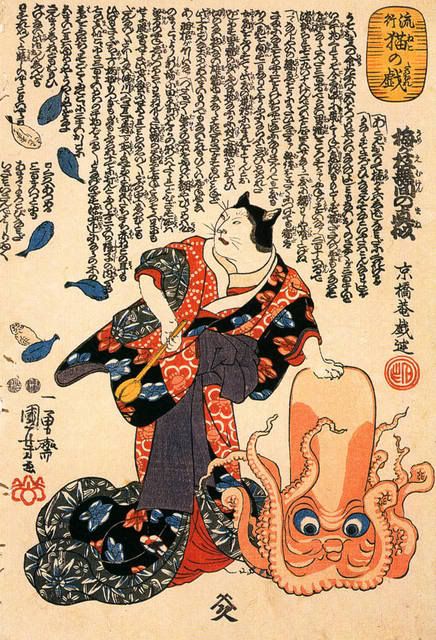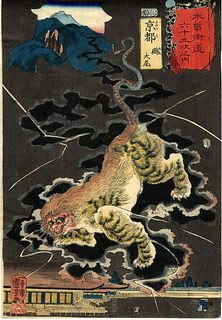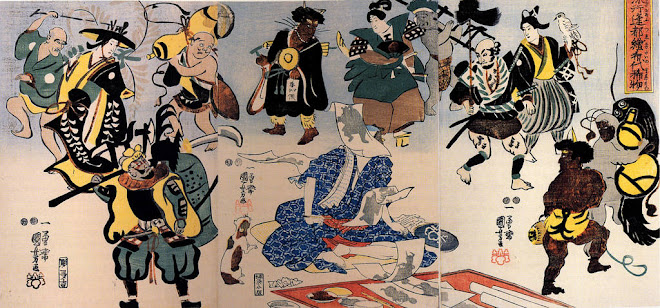Utagawa Kuniyoshi (1798-1861)
Print from the series 'Graffiti on a Storehouse Wall'1847
Nishiki-e (brocade print)
Ôban size
Signature: Ichiyûsai Kuniyoshi ga
Publisher: Ibaya Senzaburô
Censorship seals: Kinugasa and Hama
Kuniyoshi was an extremely versatile artist and was known to have studied techniques from a variety of different schools. The influence of Western-style line drawing is evident in the fluid, impromptu lines of these amusing caricatures of popular Kabuki actors.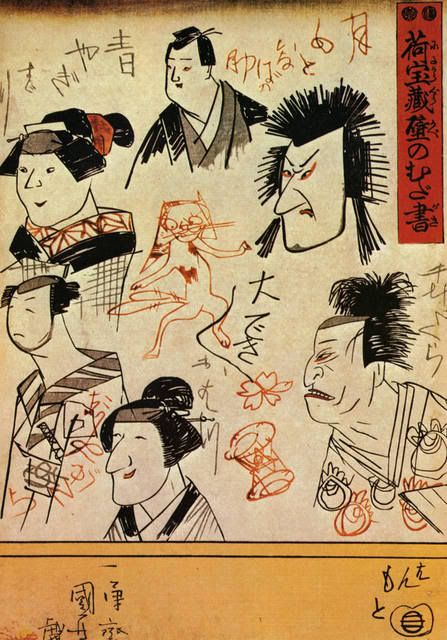
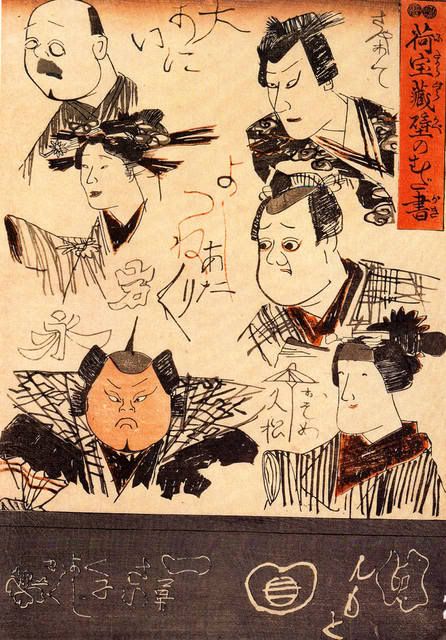
Tuesday, February 26, 2008
Kuniyoshi: Versatile, Whimsical, Comical
Monday, February 25, 2008
Kuniyoshi: Outlaw Artist Spirit
From:
http://www.viewingjapaneseprints.net/texts/ukiyoetexts/ukiyoe_pages/kuniyoshi3.html
When the Tenpô reforms of 1842 banned prints of beautiful women and kabuki actors, prints depicting warriors and legends became the life-blood of artists like Kuniyoshi. As a result he issued several large series of warrior prints in the 1840s. Yet even historical subjects could prove dangerous if treated in the wrong manner. In 1843, when Kuniyoshi designed a very popular satirical triptych of the shogun Tokugawa Ieyoshi and the earth spider, the woodblocks and remaining stocks of unsold prints were confiscated and destroyed, and Kuniyoshi was investigated and officially reprimanded.
The illustration shown here is from one of the series issued while the Tenpô Reforms were still casting a shadow over print production. Titled and shown below, Genji kumo ukiyo-e awase ("A Comparison of Prints of the Floating World with the Cloudy Chapters of Genji"), it was published by Iseya Ichibei circa 1845-46. The series is apparently complete in 60 known designs, 54 for each chapter in the Genji monogatari ("Tale of Genji") plus 6 supplemental designs. The current design is number 31 (indicated in the lower left margin) corresponding to the Makibashira ("The Cypress Pillar") chapter, with its title shown in the middle of the scroll above, and the series title appearing at the top right on the scroll cover. The Genji-kô (Genji incense emblem) for chapter 31 is shown as a repeated pattern on the scroll surrounded by a poem. A descriptive text by Hanagasa Karitsu appears below the scroll at the far left.
After the great victory on April 25, 1185 at Danoura in which Minamoto no Yoritomo and his half brother Yoshitsune defeated the Taira clan, Yoritomo, who would be designated as the first shogun of Japan, became unjustly suspicious and jealous of the brilliant military exploits of his younger brother. He refused to allow Yoshitsune entry into the headquarters in Kamakura, and instead sent him off to Horikawa in Kyoto. Yoritomo then secretly dispatched a warrior monk named Tosabô Shôshun to assassinate Yoshitsune. The attackers were defeated and Shôshun was captured and beheaded by the legendary Benkei, the warrior priest and ally of Yoshitsune. From then on Yoshitsune took flight from his murderous brother, only to be ultimately forced to commit 'seppuku' (ritual suicide) rather than be captured in a final battle at Koromogawa on May 16, 1189.
The scene in Kuniyoshi's print depicts Kurô Hangan Yoshitsune as he grasps a pillar on the balcony of the palace at Horikawa. This gesture represents an obvious pictorial pun on the cypress pillar of the Genji chapter. It also connects Yoshitsune with the metaphorical meaning of "big size" used commonly in traditional Japanese poetry for the title word 'makibashira'. At the far middle left there are military banners rising through the mist, which belong to Tosabô Shôshun and his warriors. The heroic figure of Yoshitsune standing on the railing and defiantly observing his attackers while arrows strike all around him makes this one of the more successful designs from the series. ©1999-2001 by John Fiorillo
Friday, February 22, 2008
Kuniyoshi: Nue, Legendary Creature of Misfortune
A nue (鵺) is a legendary creature found in Japanese folklore. It is described as having the head of a monkey, the body of a raccoon dog, the legs of a tiger, and a snake instead of a tail. According to the legend, nue can transform into a black cloud and fly. Due to its appearance, it is sometimes referred to as a Japanese chimera. Nue are supposed to be bringers of misfortune and illness.
According to The Tale of the Heike, Emperor Konoe, the Emperor of Japan, became sick after having terrible nightmares every night, and a dark cloud appeared at two o'clock in the morning on roof of the palace in Kyoto during the summer of 1153. The story says that the samurai Minamoto no Yorimasa staked-out the roof one night and fired an arrow into the cloud, out of which fell a dead nue. Yorimasu then supposedly sank the body in the Sea of Japan. In a local expansion of the story, the nue's corpse floated into a certain bay, and the locals, fearing a curse, buried it. A mound which exists today is supposed to be this grave.
Etymology
Nue as a word appears in the oldest of Japanese literature. Early quotes include Kojiki (712) and Wamyō Ruijushō (c. 934). Due to the usage of Man'yōgana, the historical spelling is known to have been nuye. At this early time, though, it had a different semantic meaning. It referred to a bird known as White's Thrush.
In the 13th century, Heike Monogatari makes reference to a creature called a nue. In addition to having the head of a monkey, the body of a tanuki, the paws of a tiger, and the tail of a snake, it has the voice of a White's Thrush.
Around 1435, Zeami wrote a Noh song titled Nue dealing with the events described in Heike.
Shown Below:
Taiba (The End), 1852. 9.5" by 14.25". The print depicts a Nue descending upon the Imperial palace in a black cloud.
Thursday, February 21, 2008
Ukiyo-e - The Art of Japanese Printing
A Good Description From: http://www.ancientmuseumstore.com/Samurai_in_Attack_Utagawa_Kuniyoshi_p/ku04.htm
The world portrayed by the art of Japanese printing can be captured under one romantic, by origin Buddhist, name - ukiyo-e, or the floating world. It's a world of brief amusement and pleasure - of daily life like it took place between the 17th and 19th century in theatres, on the street and during parties and festivals. Before the ukiyo-e period Japanese art was mainly about images which pleased the Japanese feudal lords - grand, colorful and elegant works of art which portrayed courtly life, made by artists who belonged to the traditional Kano and Tosa school. Little could be seen of daily life of the Japanese people. Every now and then one could catch a glimpse of the forthcoming ukiyo-e period which would portray common life in all its glory, with a leading part put aside for actors and courtesans. This changed when ukiyo-e made its entrance. After a turbulent period of political turmoil, the Tokugawa period commenced - a period which would herald a strict, dictatorial regime by the so-called Shoguns, who belonged to the Tokugawa family.
To control the population, social life was restricted and entertainment for the common Japanese was limited to parties and festivals. The artists belonging to the traditional schools like the Kano and Tosa school adapted to this new era and woodblock prints emerged presenting every day life. Soon these woodblock prints became very popular and the Tokugawa period counts as a milestone for the art of Japanese printing. Initially a print was a cheap derivative of the traditional art of painting. Due to advancing woodblock print techniques the art of wood block prints developed into a full and popular art form during the 18th century. To make a woodblock print the artist worked closely together with various craftsmen. He drew his design on a translucent piece of paper, the hanshita-e. The paper was dampened and carefully traced by the copyist onto a plate of cherry wood. The engraver carefully carved out the fine graved cherry wood, along the lines of the design, removing everything but the design lines. He could not afford to make a simple mistake, because it was irretrievable. However, his work was more than purely that of a craftsman. He was expected to revise the sometimes rough sketch of the artist into fine, fluent lines in relief in the wood. Then the artist indicated which planes should get which color and a plate was cut per color. The printer prepared and cut special paper which was made from fiber of the mulberry tree. He first printed the color planes and then meticulously the line drawing. For the paint he used materials of vegetable origin.When we look at the wood block prints now we should realize that many of the original colors have faded over the years. The publisher was the organizational and commercial keyman during the process. He gave the artist the assignment and paid the craftsmen. Sometimes the prints were put onto the market by the thousands. Because of this they became affordable, which obviously contributed to their large popularity. With this in mind it seems unjust that for a long time only the name of the artist, sometimes the name of the engraver and only seldom the publisher, was mentioned on the print.
Shown Below:
Hattara Sonja with his white tiger: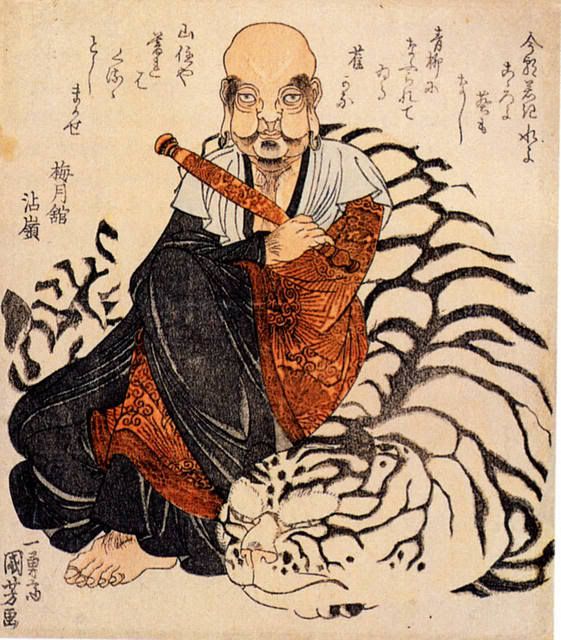
Wednesday, February 20, 2008
Utagawa Kuniyoshi - The Kuniyoshi Cat Inaguration
This blog will be dedicated to the art and influence of Utagawa Kuniyoshi.
The following is an excerpt from http://www.kuniyoshiproject.com/
The man who was to be known to history as Utagawa Kuniyoshi was born in Edo (present-day Tokyo) in 1797. He was the son of a silk dyer named Yanagiya Kichiemon and was given the name Yoshisaburô. At the age of 14, Yoshisaburô joined the Utagawa School of ukiyo-e artists, then headed by Utagawa Toyokuni I (1769 - 1825). Toyokuni I gave Yoshisaburô the name Utagawa Kuniyoshi, Kuniyoshi being a combination of Toyokuni and Yoshisaburô.
In 1814, Kuniyoshi ended his apprenticeship and set out as an independent artist. He initially produced actor prints in the style of his teacher, which gained him little recognition. Kuniyoshi achieved a commercial and artistic breakthrough in 1827 with the first six designs of the series, The 108 Heroes of the Suikoden. The series was bases upon a 14th century Chinese novel about the adventures of a band of 108 honorable bandits and rebels.
Like his teacher, Kuniyoshi had many students including Yoshitoshi, Yoshi’iku, Yoshikazu, Yoshitsuya, Yoshiyuki, Yoshifuji, Yoshifusa, Yoshiharu, Yoshikage, Yoshikata, Yoshikatsu, Yoshimori, Yoshimune, Yoshinao*, Yoshinobu*, Yoshitoyo*, Yoshitsuna, Kyôsai (briefly) and his own daughters, Yoshitora and Yoshitori. Kuniyoshi had a special fondness for cats, which overran his studio and are portrayed in many of his prints.
Although Kuniyoshi is now universally known as Utagawa Kuniyoshi, he also used the names Ichiyûsai Kuniyoshi, Chô-ô-rô Kuniyoshi, Igusa Kuniyoshi, Ichi Kuniyoshi and Saihôsa Kuniyoshi. He died from complications of a stroke on April 14, 1861.
____________
*These names were used by print artists in the city of Ôsaka as well as by the Edo artists who studied with Kuniyoshi.
Shown below:
Title: Umegae mugen no mane (Japanese) *not dated
Description: A parody (mitate) of a scene in the fourth act of the kabuki play, Simple Chronicle of the Fortunes of the Heike and Genji (Hiragana seisuiki). In the play, Genta Kagesue strikes a stone water basin and is showered with gold coins, which are thrown by his concealed mother.
